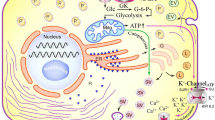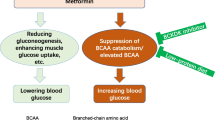Abstract
The mechanism of the respiratory inhibition caused by 4-hydroxypentenal (HPE) was studied. Observations on rat liver mitochondria indicate thatHPE inhibits phosphorylating respiration with glutamate as the substrate; DNP cannot cancel this effect. ADP-stimulated oxidation of succinate is also inhibited byHPE. The stimulating effect of DNP lasts only for about one minute, and then respiration falls to state 4 level. IfHPE is present in a concentration which by itself causes no inhibition, addition of DNP entails an inhibition of the ADP-stimulated oxidation of succinate even with uncoupling concentrations of DNP. ThisHPE + DNP induced inhibition of succinate oxidation is similar to the inhibition caused by high DNP concentration with respect to its reversibility by increased succinate concentration or oligomycin.
The activity of the DNP-stimulated ATPase is depressed byHPE. Its seems that the inhibition of the phosphorylating system is due to an inhibition of phosphate transport.
Zusammenfassung
Der Mechanismus der durch 4-Hydroxypentenal (HPE) hervorgerufenen Atmungshemmung wurde untersucht. An Rattenlebermitochondrien hemmtHPE die phosphorylierende Atmung mit Glutamat; DNP kann diesen Effekt nicht aufheben. Die ADP-stimulierte Atmung mit Succinat wird gleichfalls durchHPE gehemmt; DNP ruft nur eine kurzzeitige Stimulierung hervor. Die Atmung fällt dann auf das Niveau des State 4. IstHPE in einer Konzentration anwesend, in der es noch keine Hemmung hervorruft, bewirkt die Zugabe von DNP in einer Konzentration (0,1mm), die normalerweise entkoppelt, eine Hemmung der ADP-stimulierten Succinatverarmung. Diese durchHPE + DNP induzierte Hemmung der Succinatoxydation verhält sich gegenüber erhöhtem Succinatangebot und Oligomycin wie die durch hohe DNP-Konzentrationen hervorgerufene Hemmung.
HPE hemmt auch die DNP-stimulierte ATPase. Die in der Hemmung der Atmung und in der Hemmung der DNP-stimulierten ATPase zum Ausdruck kommenden Effekte vonHPE können auf die Hemmung des Phosphattransportes zurückgeführt werden.
Similar content being viewed by others
Literatur
I. J. Bickis, E. Schauenstein undM. Taufer, Mh. Chem.100, 1077 (1969).
E. Kapfer undE. Schauenstein, Z. Krebsforschg., im Druck.
E. Schauenstein, M. Verdino undM. Taufer, Mh. Chem.101, 1189 (1970).
A. Fluharti undD. R. Sanadi, Proc. Natl. Acad. Sci.46, 608 (1960).
M. Miyahara, Arch. Biochem. Biophys.134, 590 (1969).
N. Haugaard, N. H. Lee, R. Kostrzewa, R. S. Horn undE. S. Haugaard, Biochim. Biophys. Acta172, 198 (1969).
C. K. R. Kurup undD. R. Sanadi, Biochem.7, 4483 (1968).
B. Foucher undY. Gaudemer, FEBS Letters13, 95 (1971).
E. Schauenstein, F. Dorner undI. Sonnenbichler, Z. Naturforsch.233 316 (1968).
D. Johnson undH. Lardy, Methods in Enzymol. (Edit.R. W. Estabrook undM. E. Pullman)10, 94, Academic Press, N. Y. (1967).
D. K. Myers undE. L. Slater, Biochem. J.67, 558 (1957).
V. Lindberg undL. Ernster, Methods in Biochem. Analysis,3, 1 (1956).
K. W. Cleland undE. C. Slater, Biochem. J.53, 547 (1953).
J. Tyler, Biochem. J.111, 665 (1968).
H. Esterbauer undW. Weger, Mh. Chem.98, 1884 (1967).
H. Esterbauer, Mh. Chem.101, 782 (1970).
S. Papa, N. E. Lofromento, G. Paradies undE. Quagliariello Biochim. Biophys. Acta153, 306 (1968).
J. M. Tager in: Regulation of Metabolic Processes in Mitochondria (J. M. Tager, S. Papa, E. Quagliariello undE. C. Slater, eds.), p. 202; BBA Library Elsevi Amsterdam (1966).
C. E. Wenner, Federation Proc.24, 544 (1965).
J. B. Chappell undK. N. Haarhoff in: Biochemistry of Mitochondria (eds.E. C. Slater, Z. K. Kaniuga undL. Wojtczak), pp. 75–91. Academic Press N.Y. (1967).
D. F. Wilson undR. D. Merz, Arch. Biochem. Biophys.119, 470 (1967).
K. van Dam undC. S. Tsou, Biochim. Biophys. Acta162, 301 (1968).
Author information
Authors and Affiliations
Additional information
Herrn Prof. Dr. Dr. h. c.O. Kratky zum 70. Geburtstag gewidmet.
Mit 2 Abbildungen
Rights and permissions
About this article
Cite this article
Zollner, H. Die Wirkung von 4-Hydroxypentenal auf die phosphorylierende Atmung und auf verwandte Prozesse in Rattenlebermitochondrien. Monatshefte für Chemie 103, 1276–1284 (1972). https://doi.org/10.1007/BF00904512
Received:
Issue Date:
DOI: https://doi.org/10.1007/BF00904512




